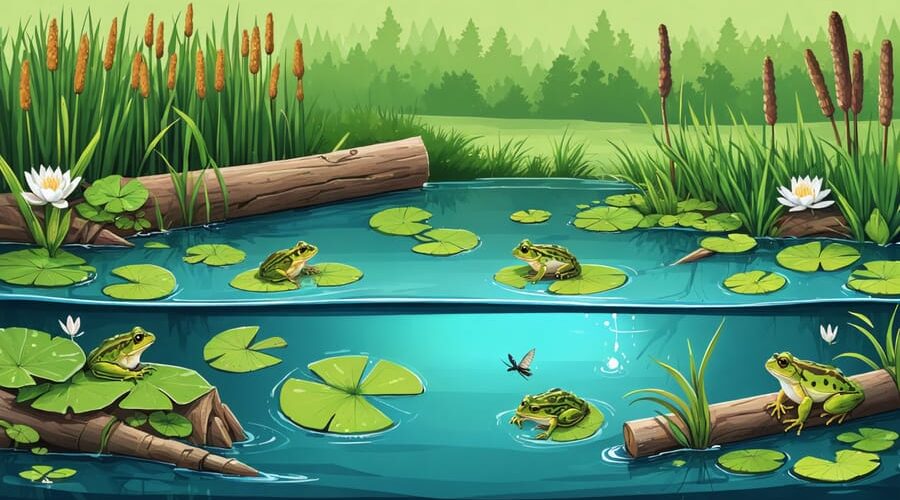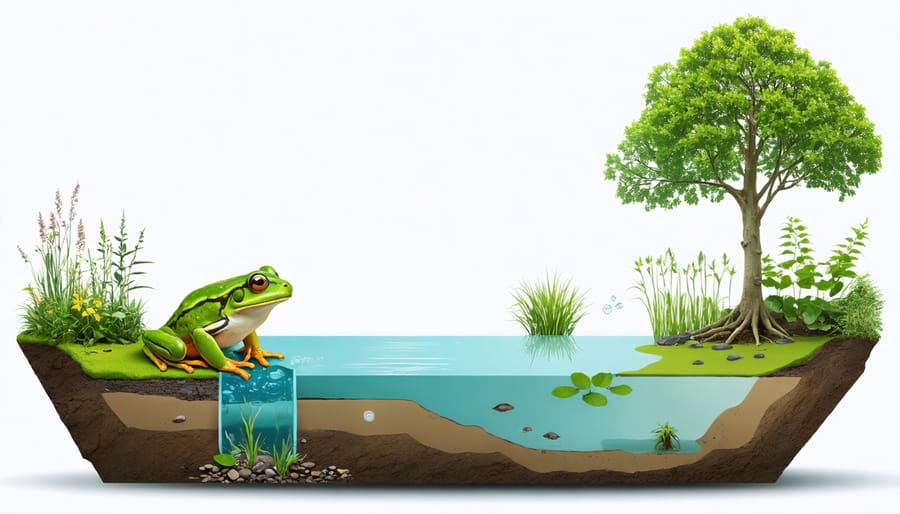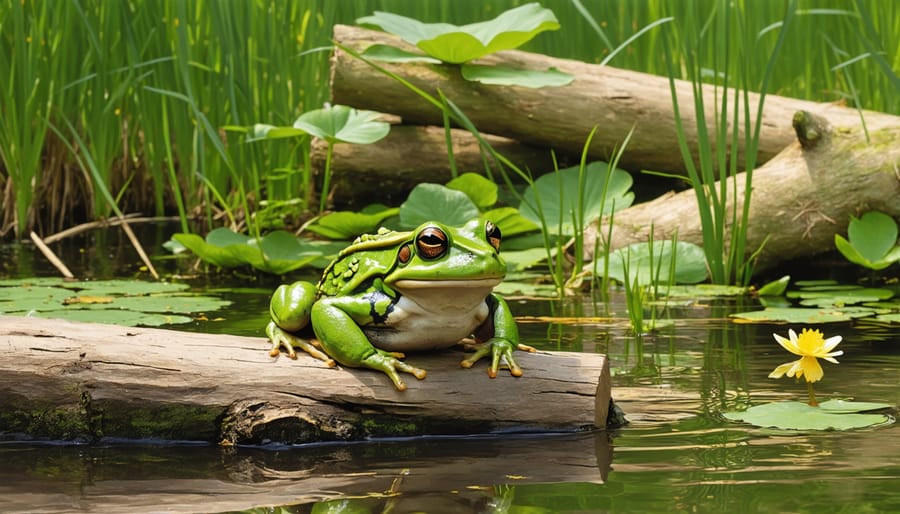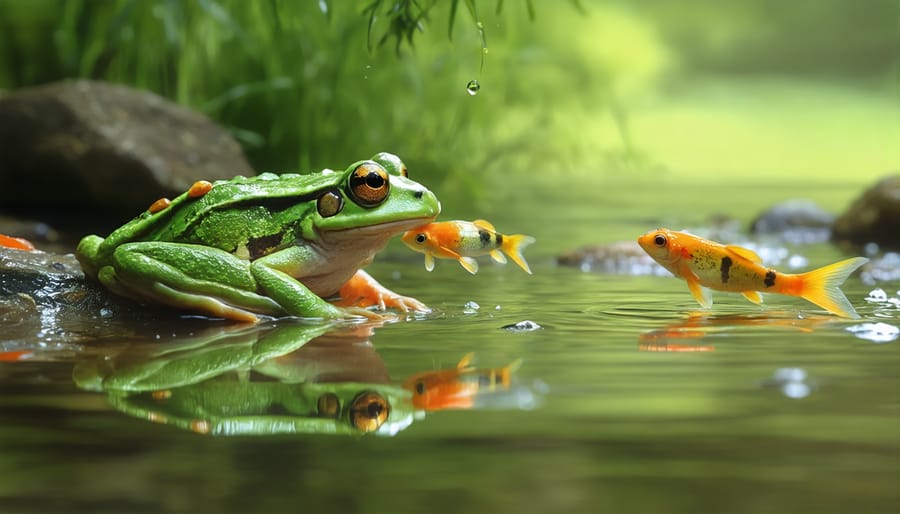
Transform Your Pond into a Thriving Frog Paradise: Proven WMA Techniques
Transform your backyard into a thriving frog habitat by strategically designing a Wildlife Management Area (WMA) around your pond. Start with diverse water depths – shallow margins for breeding, deeper zones for hibernation, and varied depths in between for different frog species. Install partially submerged logs and native aquatic plants like cattails and water lilies to create essential hiding spots and natural barriers. Master the art of creating balanced aquatic ecosystems by maintaining proper water quality through natural filtration and regular monitoring of pH levels.
Maintain year-round water levels and ensure gradual slopes around pond edges to support safe amphibian movement. Position rocks and native vegetation strategically to create microhabitats that protect frogs from predators while providing essential sunbathing spots. Keep the surrounding area pesticide-free and incorporate ground cover plants to maintain soil moisture and create natural corridors between water features.
This specialized habitat design not only supports local frog populations but also attracts beneficial insects and creates a self-sustaining ecosystem that enhances your property’s biodiversity. Regular maintenance and careful observation will help you fine-tune your WMA to meet the specific needs of your local amphibian species.
Creating the Perfect Frog Habitat
Water Depth and Zoning
Creating the perfect habitat for frogs requires careful attention to water depth and shoreline design. Different frog species have varying preferences, so incorporating multiple depth zones is key to attracting diverse wildlife. The ideal frog pond should include shallow areas ranging from 2-6 inches deep, which serve as vital breeding grounds and tadpole nurseries during spring and summer months.
Along the edges, maintain gradual slopes of approximately 20-30 degrees to allow easy access for frogs entering and exiting the water. The middle section should drop to about 2-3 feet deep, providing essential refuge during winter months when frogs hibernate. This deeper zone also helps maintain stable water temperatures and protects frogs from predators.
Include several “step” levels throughout your pond, creating a natural transition between depth zones. For example, start with a beach-like entry point that gradually descends to a 6-inch shelf, then slopes down to an 18-inch middle section, before reaching the deeper central area.
Remember to incorporate plenty of aquatic plants at various depths. Shallow margins should feature emergent vegetation, while the deeper zones can host submerged plants that provide cover and support for egg masses. This varied topography not only accommodates different frog species but also creates a more natural and sustainable ecosystem that benefits all pond inhabitants.

Vegetation Selection and Placement
Creating a thriving habitat for frogs requires thoughtful selection and placement of vegetation. The key is to incorporate a variety of aquatic plants for different depths to provide essential cover, breeding spots, and feeding areas.
For the shallow margins, plant cattails, rushes, and sedges. These emergent plants offer perfect spots for frogs to rest and hunt insects. Water lilies and floating plants like duckweed create essential surface coverage, providing shelter from predators and helping regulate water temperature.
In deeper areas, submerged plants like hornwort and water milfoil create underwater forests where tadpoles can safely develop. These plants also support small aquatic insects that serve as food for both tadpoles and adult frogs.
Remember to include plants around the pond’s perimeter too. Native grasses and low-growing shrubs create natural corridors for frogs moving between water and land. Moisture-loving plants like ferns and mosses help maintain humidity levels that frogs need to thrive.
Avoid overcrowding your pond with vegetation – aim for about 60% plant coverage, leaving open areas for frogs to swim and catch prey. Group similar plants together in clusters to create distinct microhabitats that support different frog activities throughout their lifecycle.
Wildlife Management Strategies
Predator Control Methods
In any frog pond environment, maintaining ecological balance is crucial for the survival of these sensitive amphibians. Natural predator control methods focus on creating safe spaces while preserving the pond’s biodiversity. Installing partially submerged logs and floating plants provides frogs with essential escape routes and hiding spots from predatory birds and mammals.
Strategic plant placement around the pond’s edges helps deter unwanted visitors while supporting beneficial insects. Dense vegetation like cattails and rushes creates natural barriers against raccoons and other ground predators. Adding specific native plants that attract dragonflies can help control mosquito populations without harming frogs.
Motion-activated sprinklers offer a harmless way to startle larger predators, while proper pond depth (at least 2-3 feet in some areas) gives frogs safe refuge. Creating shallow, gently sloping edges allows frogs to easily enter and exit the water while making it harder for predators to access the pond.
Instead of using harmful chemicals, encourage natural pest control by welcoming beneficial insects and creating microhabitats. Small rock piles and brush heaps near the pond provide additional shelter for frogs while deterring unwanted visitors. Remember to avoid introducing fish species that might prey on tadpoles and maintain water quality through natural filtration methods.

Water Quality Management
Water quality plays a crucial role in maintaining a healthy habitat for frogs and other amphibians at Frog Pond WMA. Regular monitoring of key water parameters ensures optimal conditions for these sensitive creatures. The management team conducts weekly tests for pH levels, which should typically range between 6.5 and 7.5 to support amphibian life.
Dissolved oxygen levels are maintained through natural aeration systems and strategic placement of aquatic plants. These plants not only help oxygenate the water but also provide essential cover for tadpoles and adult frogs. The management team also monitors nitrogen and phosphorus levels to prevent excessive algae growth, which can deplete oxygen and harm amphibian populations.
Temperature regulation is another critical aspect of water quality management. The pond’s depth varies strategically, creating both shallow warming areas for breeding and deeper, cooler zones for refuge during hot summer months. Surrounding vegetation helps provide natural shade, maintaining stable water temperatures.
Seasonal water testing becomes especially important during spring breeding seasons when amphibians are most vulnerable. The management team also implements measures to prevent chemical runoff from nearby areas, maintaining buffer zones and filtering systems where necessary. This comprehensive approach to water quality management has resulted in a thriving amphibian population and serves as a model for similar wildlife management areas.
Seasonal Maintenance Tips
Maintaining a frog-friendly habitat requires different approaches throughout the year. In spring, focus on removing winter debris and checking water quality as amphibians emerge from hibernation. Clear fallen leaves and branches while being careful not to disturb any early-season frog activity.
Summer maintenance involves managing vegetation growth and monitoring water levels. Keep aquatic plants in check by trimming back overgrowth, which helps maintain open water areas essential for frog movement. During dry spells, add fresh water as needed, but avoid sudden large changes that could stress the habitat’s ecosystem.
Fall preparations are crucial for winter survival. Leave some fallen leaves around the pond edges as natural shelter, but remove excess to prevent water quality issues. Consider installing a small pump or aerator to maintain an ice-free spot during winter, which helps with gas exchange and provides vital access points for frogs.
Winter requires minimal intervention, but occasional monitoring is important. Clear heavy snow from ice to allow light penetration for underwater plants. Avoid breaking ice directly, as the vibrations can disturb hibernating frogs.
Year-round, maintain a buffer zone of native plants around the pond edge, providing natural shelter and food sources for frogs. Regular water quality checks and gentle debris removal help ensure a healthy habitat across seasons. Remember that a thriving frog population indicates a well-balanced ecosystem, so avoid using chemicals or pesticides near the pond area.
Integration with Other Pond Life
Compatible Fish Species
When selecting fish species for your frog pond, it’s essential to choose varieties that coexist peacefully with amphibian populations. Native fish species are typically the best choice, as they’ve evolved alongside local frog species. Smallmouth bass, bluegill, and golden shiners make excellent companions, as they help control insect populations without threatening adult frogs or larger tadpoles.
Avoid introducing aggressive or large predatory fish like largemouth bass or pike, as these can quickly diminish your frog population. Instead, opt for smaller fish species that primarily feed on insects and algae. Mosquito fish are particularly beneficial, as they help control mosquito larvae while posing minimal risk to frog eggs and tadpoles.
Consider including fathead minnows, which serve as a food source for larger frogs while helping maintain water quality. White cloud mountain minnows and rosy red minnows are also excellent choices, as they stay small and won’t compete with frogs for resources.
For optimal balance, maintain a fish density of about 1-2 inches of fish per 10 gallons of water. This ensures enough space for both fish and frogs while preventing overcrowding. Remember that some fish may naturally reproduce in your pond, so start with fewer fish than your maximum capacity to allow for population growth.
Always research local regulations regarding fish stocking, as some species may be restricted in your area. Regular monitoring of both fish and frog populations will help you maintain a healthy ecosystem where both species can thrive.

Beneficial Insects and Invertebrates
A thriving frog pond ecosystem depends heavily on the presence of beneficial insects and other invertebrates that create a balanced habitat. Supporting beneficial pond invertebrates is crucial for maintaining a healthy environment where frogs can flourish.
Dragonflies and damselflies are particularly valuable residents, as they help control mosquito populations while adding vibrant colors to your pond setting. Water striders glide across the surface, creating gentle ripples that add life to the water while feeding on smaller insects. Beneath the surface, freshwater snails and crayfish work as natural cleaners, consuming algae and decomposing plant matter.
Diving beetles and water boatmen contribute to the ecosystem by feeding on mosquito larvae and other small aquatic organisms. These creatures also serve as a food source for growing tadpoles and adult frogs. Adding native aquatic plants creates perfect hiding spots for these beneficial insects while oxygenating the water.
To encourage these helpful creatures, maintain varying water depths and include plenty of natural debris like fallen leaves and small branches. Avoid using chemical pesticides or treatments that might harm these important pond inhabitants. Remember, a diverse population of insects and invertebrates indicates a healthy ecosystem that will naturally support your frog population.
Common Challenges and Solutions
Managing a frog pond wildlife management area comes with its fair share of challenges, but most issues have practical solutions. One common problem is maintaining proper water quality, especially during hot summer months when algae growth can become excessive. Regular water testing and introducing beneficial aquatic plants can help balance the ecosystem naturally. If algae persist, consider adding a small fountain or aerator to increase oxygen levels.
Predator management often presents difficulties for pond managers. Raccoons, snakes, and birds may prey on frogs and tadpoles. Creating multiple hiding spots using rocks, logs, and dense vegetation provides essential cover. Installing partially submerged branches and floating platforms gives frogs quick escape routes when threatened.
Seasonal water level fluctuations can stress frog populations. During dry spells, shallow areas might dry up, potentially threatening tadpole development. Installing a simple water level monitor and having a backup water source ready helps maintain consistent levels. In areas prone to flooding, creating overflow channels prevents complete habitat disruption.
Disease outbreaks, particularly fungal infections, can affect frog populations. Regular monitoring for signs of illness, such as unusual behavior or skin changes, allows for early intervention. Maintaining clean water and avoiding overcrowding helps prevent disease spread. If you notice sick frogs, consult with local wildlife experts for guidance.
Invasive species can disrupt the natural balance of your frog pond. Non-native plants may choke out beneficial vegetation, while introduced fish species might prey on tadpoles. Regular monitoring and prompt removal of invasive species helps protect the habitat. Work with local conservation authorities to identify and manage problematic species effectively.
Temperature regulation can be challenging, especially in smaller ponds. Creating varying depths ensures frogs can find comfortable temperatures year-round. Deep areas provide winter refuge, while shallow sections offer warm basking spots. Adding shade plants around the pond helps moderate water temperature during extreme weather.
Creating and maintaining a frog pond wildlife management area is a rewarding endeavor that benefits both local ecosystems and our communities. By following sustainable management practices, such as maintaining water quality, preserving native vegetation, and controlling invasive species, we can ensure these valuable habitats thrive for generations to come. Remember to monitor amphibian populations regularly, adjust management strategies as needed, and engage with local conservation groups to stay informed about best practices. Through careful stewardship, we can create vibrant wetland spaces that support diverse wildlife while providing educational and recreational opportunities for everyone. Let’s work together to protect these precious ecosystems and ensure our frog ponds remain healthy, sustainable sanctuaries for wildlife.
